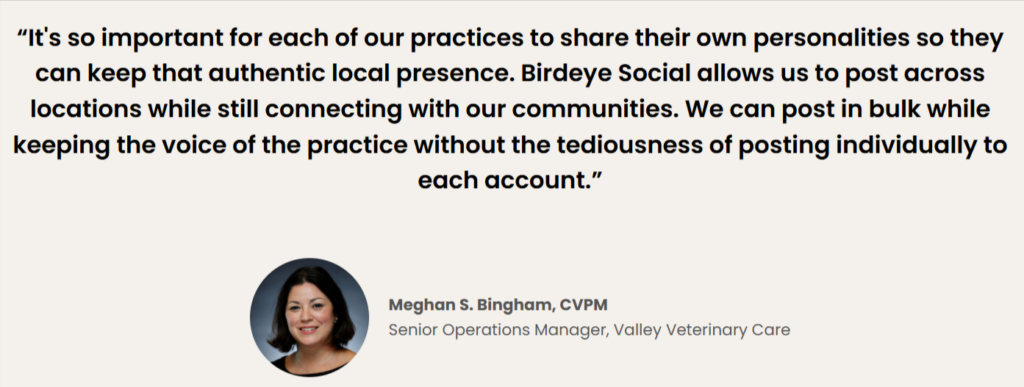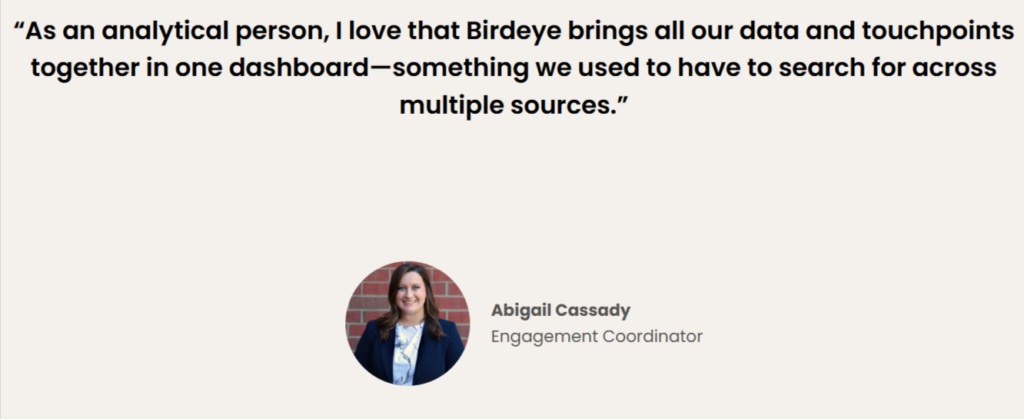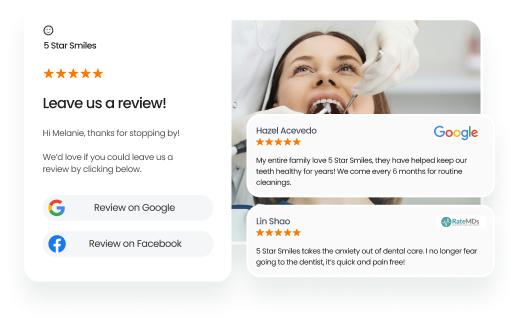Testimonial advertising has quietly become the most credible tool in a marketer’s arsenal — not because it’s flashy, but because it’s real.
When ad fatigue sets in and skepticism rises, polished campaigns fall short. What today’s customers want isn’t another bold promise — they want proof. And nothing builds that faster than hearing directly from someone who’s been in their shoes.
The problem? Most businesses still rely on traditional ads while ignoring the authentic stories in their inboxes, review feeds, and support logs. That’s where they’re missing out.
In this blog, you’ll learn what testimonial advertising is, why it works, how it’s shifting in 2025, and why top brands are using GenAI tools like Birdeye to collect and scale testimonial ads that feel more relatable and convert better.
Trust that sells itself: People don’t believe brands. They believe other people. But not all testimonials are created equal. The ones that convert? They’re specific, relatable, and placed in the right moment — like a nudge from a friend who’s already taken the leap.
We’ll show you how to build testimonial ads that don’t just look good, but make your product or service irresistible.
Table of contents
- What is testimonial advertising?
- 9 types of testimonial advertising (with real examples)
- How testimonial advertising is evolving in 2025
- How can you make your testimonial ad stand out and drive action?
- How to stay compliant with legal and FTC’s ethical guidelines for testimonial advertising
- Scale testimonial advertising with Birdeye GenAI tools
- Frequently asked questions about testimonial advertising
- Businesses choose Birdeye for testimonial advertising success
What is testimonial advertising?
Testimonial advertising is a powerful marketing strategy that uses endorsements from satisfied customers to promote a product or service. These endorsements can take many forms – from written testimonials and video testimonials to social media posts and user-generated content. And they serve a single purpose: building trust.
By showcasing real customer stories, brands can convince potential customers using experiences instead of claims. The result? Stronger engagement, more clicks, and more conversions — because people don’t trust ads, they trust other customers.
This approach adds social proof to your message and helps potential buyers imagine themselves having the same positive experiences. That makes it far more impactful than a generic brand claim or polished pitch.
In short, if you're looking for a quick testimonial advertising definition, it's a form of marketing that builds trust by letting real customers do the talking — making it far more persuasive than polished pitches.
Why does it convert better than traditional ads?
Traditional ads might grab attention but often fall flat when building trust. Today’s consumers scroll past marketing fluff and spot exaggeration a mile away. They’re not interested in what you say about yourself but in what people like them say about you.
That’s why brands are replacing scripted promos with authentic testimonials from real customers. This isn’t just a trend — it’s a smarter way to sell. A testimonial that shows transformation, emotion, or relief is more persuasive than any brand talking point.
Testimonial advertising stands out because it’s rooted in credibility. It brings real-world voices to your ads, removes doubt, and encourages action, especially when it reflects existing customers’ voices across your marketing channels.
👉 Let’s break down where traditional advertising often misses the mark.
Why do traditional ads fall short today?
- They lack social proof and often sound scripted.
- They fail to reflect the real experiences of existing customers.
- They miss the opportunity to build credibility through a human connection.
👉 Now compare that with what testimonial advertising brings to the table.
Why testimonial advertising converts better
- It puts customer feedback and real-world outcomes front and center.
- It shows specifics: emotional journeys, success stories, and solutions.
- It mirrors how people make purchasing decisions, based on what other consumers say.
Testimonial advertising example: What you can learn from Glossier’s Instagram testimonial ad
Beauty brand Glossier offers a masterclass in relatable, high-performing testimonial ads. By featuring authentic customer reviews in their signature minimalist design, Glossier allows the testimonial to take center stage, reinforcing the product’s quality through the voice of a real customer. This approach builds trust and resonates with their target audience, increasing engagement and conversions.
One example from an Instagram post featured the review:
“I’ve been using Futuredew every day for months. It gives me a glow without making me oily.”
No celebrity, no script — just a real review from a loyal customer, formatted like a casual Instagram post. The result? Higher engagement means better conversions — all without a big production budget.
These ads work because they meet today’s consumers where they are: craving relatability, not perfection.
So, instead of pouring your budget into traditional campaigns that may or may not land, testimonial advertising delivers what your audience trusts — proof from people like them.
Here’s another customer testimonial clip from Glossier:
That’s the power of using a testimonial in advertising — it becomes less about you and more about the people who trust you. Now let's explore some of the best testimonial advertising by brands that've cracked the code.
9 types of testimonial advertising (with real examples)
There’s no one-size-fits-all when it comes to testimonial advertising. The format you choose can determine whether your message resonates or gets ignored. The best testimonial ads don’t just quote a happy customer — they package the story in a real, relevant, and platform-appropriate way.
Let’s examine nine high-performing formats for testimonial advertising in 2025 and provide tips on where they work best.
1. Video testimonials
A short, unscripted video of a real customer explaining how your product or service made a difference. These build emotional connection, add tone, and increase watch time.
Slack tops our list as one of the best testimonial ad examples. It features short clips of teams explaining how it simplifies daily workflows.
Best for: Social ads, homepage videos, YouTube Shorts, landing pages
Should I collect more customer testimonials before running ads?
Yes. Gathering more customer testimonials gives you the variety needed to test formats, match different buyer personas, and find the stories that truly convert.
2. Text testimonials with visual design
A customer quote paired with branding, a customer photo, or a product visual is great for scroll-friendly formats.
Example: Glossier features short customer quotes over product images in carousel-style instagram posts.
Best for: Retargeting ads, email campaigns, mobile-first display ads
3. Social proof screenshots
Unedited snapshots of positive comments, reviews, or DMs. These convey authenticity and relatability.
Example: BarkBox shares customer tweets and Instagram comments in Stories and TikTok slideshows.
Best for: Social media posts, Stories, product features, brand pages
4. Long-form written testimonials
Detailed quotes with backstory, challenge, and results. Ideal for higher-stakes or trust-based offerings.
Example: Birdeye’s Customer Experience Heroes page includes in-depth customer narratives about customer experience and ROI they got after implementing Birdeye platforms in their workflow.
🎉 Meet the Customer Experience Heroes
See how real businesses use Birdeye to level up their customer experience.
Explore StoriesBest for: Blogs, landing pages, comparison content
5. UGC-based testimonials (user-generated content)
Customer-submitted videos or photos using your product. UGC is powerful consumer-generated content that feels real and unfiltered.
Example: GoPro showcases UGC from adventure users on Instagram, often repurposed into ads.
Best for: TikTok, Instagram Reels, UGC ads, Instagram stories
Create scroll-stopping testimonial ads your customers will trust
Want to see the impact of Birdeye on your business? Watch the Free Demo Now.
6. Influencer testimonials
Endorsements from niche creators or micro-influencers who align with your target customers. These blends reach with relatability.
Example: Athletic Greens partners with wellness influencers who post authentic “daily use” routines in Stories.
Best for: Influencer whitelisting ads, sponsored reels, email
7. Carousel quote collections
Multiple short quote testimonials featured in a single scrollable ad. This format helps build broad credibility by showing consistent satisfaction.
Example: Canva’s carousel ads feature praise from educators, designers, and business teams.
Best for: Facebook, LinkedIn, multi-location ad sets
8. Before-after testimonial clips
This format shows transformation visually and narratively, especially for health, fitness, beauty, and home improvement brands.
Example: Peloton’s ads show customer journeys from inactivity to daily motivation — often with measurable stats.
Best for: Video ads, retargeting, product pages
9. Client success interviews
Think of this as the storytelling version of a testimonial, often framed as a case study. It includes challenge, action, and result and adds rich details.
Example: Salesforce publishes 1–2 minute case study reels on YouTube, often repurposed as landing page embeds.
Best for: B2B, SaaS, multi-location case studies
5 testimonial ad types worth testing this year
| Format | Why it works |
|---|---|
| Story-style Instagram testimonial | Feels native, easy to swipe through, great for positive comments |
| Before-after UGC clip | Shows transformation and taps into emotion |
| Customer quote carousel | Allows multiple voices to shine in one ad |
| Influencer testimonial mashup | Combines reach with social proof from people who reflect your target customers |
| Video ad with customer narration | Puts the story in the customer’s voice — not the brand’s |
Testimonial advertising isn't static. As customer behavior evolves and GenAI transforms how we gather and scale feedback, this strategy is undergoing a major shift. Let’s explore what’s changing — and how to stay ahead of the curve in 2025.
How testimonial advertising is evolving in 2025
Testimonial advertising isn’t just surviving the digital shift — it’s adapting faster than most strategies in the marketing playbook. With the rise of GenAI, omnichannel engagement, and changing consumer behavior, this method of customer storytelling is becoming smarter, faster, and more performance-driven.
If you’re still treating testimonials as passive website fillers or static quotes, you’re missing what this strategy is becoming: a dynamic engine for growth across ads, landing pages, social media, and even Google Ads.
Let’s break down how testimonial ads are evolving in 2025 — and what that means for your business:
Rise of short-form, mobile-first video testimonials
Text testimonials still matter — but video is where emotions land. Businesses now record real customers explaining how a product or service improved their lives. With mobile editing tools and repurposing tech, you don’t need big production to get a big impact.
Trust and compliance are no longer optional
As AI-generated content rises, customers want to know what’s real. Verified reviews, timestamps, source attributions, and consent-based use of customer photos or names have become baseline customer expectations. Platforms are cracking down, too, meaning authentic testimonials and transparency are the safest long-term bet.
Sentiment-driven creative decisions
Businesses now use emotion tracking and language sentiment tools to select the most persuasive customer quotes. That means your best-performing testimonial ads may not be the flashiest, but the ones that reflect honesty, vulnerability, or joy.
Strategic measurement across the funnel
In 2025, testimonial performance isn’t judged by likes. Brands are tracking how these ads:
- Reduce bounce on landing pages
- Increase CTR in email campaigns
- Boost trust in Google ads
- Influence repeat purchases from loyal customers
So yes, testimonial advertising is changing — and quickly. The businesses winning in 2025 aren’t just collecting more reviews. They’re turning them into personalized, omnichannel stories that reach the right audience at the right time.
Of course, understanding how testimonial advertising is evolving is only half the story. To put it into action, you need the right format — one that fits your message, audience, and platform. Let’s break down the anatomy of a great testimonal ad.
How can you make your testimonial ad stand out and drive action?
It’s not enough to just show praise — great testimonial ads go beyond words and build emotional momentum. They persuade by showcasing specific benefits, delivering authentic feedback, and aligning with your audience’s attention span. In 2025, with so much content competing for visibility, your ad has only seconds to land — and even less time to earn trust.
So, what turns a good testimonial into a high-performing one? It’s all about structure, tone, and placement.
1. Focus on transformation, not compliments
Generic praise doesn’t sell. Quote testimonials like “Excellent service!” or “Highly recommend!” sound like filler. Instead, showcase how your product or service changed someone’s experience — the shift from problem to outcome.
Instead of: “Great product!”
Try: “I went from 2 leads a week to 10 — without changing my marketing efforts.”
2. Highlight specific benefits and outcomes
Your audience doesn’t just want to know you’re good — they want to know how you help. Choose testimonials that highlight tangible results: saved time, increased conversions, and less stress.
Instead of: “We love it!”
Try: “We reduced response time by 60% and saw a 40% bump in rebookings — all within the first month.”
3. Choose authentic testimonials over scripted praise
Overly polished ads feel like… ads. But real stories, even if imperfectly told, build credibility. Let your most loyal customers speak in their voice. Embrace tone, pauses, even emojis — that’s where authenticity lives.
Instead of: “Your customer service is the best!”
Try: “Your support team actually called me when I left a review. Never had that happen before. You guys care — and it shows.”
4. Match ad copy with platform and format
Every platform has a different rhythm. What works on a blog may flop on TikTok. Keep written reviews longer for landing pages, and use shorter clips or animated text for video ads on social.
Long-form for landing page:
“We’ve been using [Company] for 8 months across 6 locations. Our listings are finally clean, our reviews are flowing in, and we’re actually ranking.”
Short-form for Instagram:
“Reviews went up, stress went down. 🙌”
5. Align the testimonial with your buyer’s situation
Choose stories that your potential customers can relate to. If you’re targeting first-time buyers, don’t use a testimonial from someone five years into their journey. Relevance builds a connection fast.
Instead of: “Our enterprise team loves your integrations.”
Try: “As a small med spa, we had no idea where to start. But the onboarding was simple — and within days, we saw reviews roll in.”
However, while high-performing testimonial ads can boost credibility and conversions, one critical element brands can’t overlook is compliance. Let’s break down the legal and ethical rules you must follow to protect your reputation and results.
How to stay compliant with legal and FTC’s ethical guidelines for testimonial advertising
As testimonial advertising grows in popularity, so does scrutiny. The FTC is paying closer attention to how businesses use customer testimonials, especially in ad copy that influences purchasing decisions. That means businesses can’t afford to treat compliance as an afterthought — it’s now central to building trust and avoiding penalties.
Here’s what you need to keep in mind when using testimonial ads in your marketing efforts:
1. Always disclose relationships or incentives
If a customer receives a discount or free product in exchange for their feedback, you must make that clear. Transparency is key—even if it’s just a “thank you” gift.
Example: “This customer received a complimentary service in exchange for their honest review.”
2. Use real experiences and avoid exaggeration
Never twist or overstate what your current customers said. If someone gave a mild compliment, don’t turn it into a raving endorsement. Use the actual quote or clarify with context.
Instead of: “Changed my life!” (taken out of context)
Use: “It’s made daily scheduling a lot less stressful — I feel more organized.”
3. Choose authentic feedback, not idealized praise
Avoid publishing only the best reviews. While it’s okay to curate, cherry-picking only glowing testimonials (or, worse, fake ones) can damage trust, especially if customers find other consumers sharing a very different story elsewhere.
Tip: Feature a mix of consumer-generated content to show range, not just perfection.
4. Get permission before using names, images, or videos
Always ask for permission in writing, especially for Facebook video testimonial ads or customer photos. You’ll also want to clearly state how the content will be used (e.g., ads, emails, social).
5. Keep records of endorsements
The FTC recommends maintaining documentation for all influencer testimonials, especially if there’s compensation involved. This protects your brand from future claims of deceptive marketing.
The bottom line? Staying compliant isn’t just a legal necessity — it’s a signal of trust. And trust is what makes successful testimonial advertising possible in the first place.
Now that you know how to keep testimonial campaigns compliant and credible, let’s talk about how Birdeye’s GenAI tools help you launch, automate, and optimize high-performing testimonial ads across every touchpoint.
Scale testimonial advertising with Birdeye GenAI tools
Creating one great testimonial ad is powerful. But scaling that success across 20, 200, or even 2,000 locations? That’s where most businesses struggle, especially when they’re juggling multiple platforms, compliance, and customer stories at once.
Birdeye, an AI company built for multi-location brands, helps bridge that gap. With its suite of GenAI tools, you can collect testimonials, identify what resonates, and create personalized, performance-ready testimonial ads — all from the customer feedback you already have.
Here’s how each tool plays a role in scaling your testimonial advertising strategy:
Reviews AI: Turn customer feedback into ready-to-use content
- Automatically surfaces the best-written reviews, quotes, and positive experiences.
- Filters content by sentiment, location, or service.
- Identifies and transforms high-performing phrases into short-form or long-form ad copy.

Insights AI: Understand what drives performance
- Detects review patterns across products, locations, or industries.
- Highlights specific benefits mentioned most often by satisfied customers.
- Helps you decide which testimonials match which target customers.

Social AI: Repurpose for every platform — fast
- Converts testimonials into ready-made creatives for social media posts, Stories, and carousels.
- Suggests captions, hashtags, and visual themes based on sentiment.
- Helps you repurpose UGC and Instagram posts into scalable assets.

Competitors AI: Benchmark against your category
- Tracks how competing brands use testimonial advertising examples.
- Identifies keyword gaps and positioning opportunities.
- Helps refine messaging and creative direction.
With Birdeye’s GenAI platform, you don’t just scale content — you scale what’s already working. And you do it in a way that keeps your brand voice consistent, your campaigns compliant, and your testimonials always customer-first.

Frequently asked questions about testimonial advertising
They showcase real stories from satisfied customers to increase trust, engagement, and conversions across platforms — especially on social media channels.
Not exactly. Influencer testimonials offer niche relevance and relatability. Celebrity status can help with awareness, but it’s less trusted than peer feedback.
Yes — it’s one of the most cost-effective ways to promote your brand. You’re leveraging existing customer feedback across various marketing channels with minimal production cost.
Absolutely. The right testimonial can drive sales, increase trust, and add credibility by showing personal experiences from a real person your target audience relates to.
Businesses choose Birdeye for testimonial advertising success
The most trusted ads aren’t written by your brand — they come from your customers. But collecting, scaling, and activating testimonials across platforms isn’t easy without the right system.
That’s where Birdeye steps in.
Birdeye is a GenAI platform built for multi-location businesses looking to turn customer testimonials into a powerful tool for growth. From sourcing authentic feedback to distributing it across various marketing channels, Birdeye helps brands do more — without more effort.
Here’s how Birdeye helps brands increase sales, drive engagement, and add credibility — all with customer stories:
- Reviews AI automates the process of collecting and curating personal experiences from real customers.
- Insights AI reveals which testimonials match your audience’s biggest motivators.
- Social AI repurposes feedback into social-ready, platform-native formats.
- Competitors’ AI benchmarks performance and uncover gaps in expert endorsements and trust-building strategies.
With Birdeye, you don’t need a big budget or a celebrity face. You just need real stories framed the right way — in a few words, at the right time, on the right channel.
Want to scale testimonial advertising that works?

Originally published









